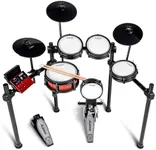Buying Guide for the Best Electronic Drum Kit
Choosing the right electronic drum kit can be an exciting process, especially with so many options available. The best approach is to think about how and where you plan to use the kit, your experience level, and what features matter most to you. Whether you’re a beginner, a hobbyist, or an experienced drummer, understanding the key specifications will help you find a kit that matches your needs and supports your musical growth.Number of PadsThe number of pads on an electronic drum kit refers to how many drum and cymbal surfaces you can play. This is important because it determines how many different sounds and playing options you have. Kits with fewer pads (like 5 or 6) are simpler and often better for beginners or those with limited space, while kits with more pads (7 or more) offer a wider range of sounds and are better for advanced players or those who want to mimic a full acoustic drum set. Think about the style of music you want to play and whether you need extra pads for things like additional toms or cymbals.
Pad Type (Rubber vs Mesh)Pad type refers to the material used for the drum surfaces. Rubber pads are durable and often found on entry-level kits, providing a firm feel and louder stick response. Mesh pads are more advanced, offering a quieter, more realistic feel similar to acoustic drums, and are often adjustable for tension. If you want a more authentic drumming experience or need to keep noise down, mesh pads are a great choice. If you’re just starting out or want something more rugged, rubber pads can be sufficient.
Sound Module FeaturesThe sound module is the brain of the electronic drum kit, controlling the sounds, effects, and connectivity. Key features include the number and quality of built-in drum sounds, the ability to import your own sounds, built-in coaching or practice tools, and connectivity options like USB or MIDI. If you want lots of sound variety or plan to record or connect to other devices, look for a module with more features. Simpler modules are easier to use and can be great for beginners.
Connectivity OptionsConnectivity refers to how the drum kit can connect to other devices, such as computers, headphones, amplifiers, or recording equipment. Common connections include headphone jacks, audio outputs, USB, and MIDI. If you want to practice quietly, make sure there’s a headphone output. For recording or using music software, USB or MIDI connections are important. Consider what you want to connect your kit to, and make sure the kit supports those options.
Size and AdjustabilityThe size and adjustability of the kit affect how well it fits in your space and how comfortable it is to play. Some kits are compact and designed for small rooms, while others are larger and more adjustable, allowing you to set up the pads and cymbals just like an acoustic kit. If you have limited space, look for a compact kit. If comfort and a realistic setup are important, choose a kit with more adjustability.
Kick Pedal TypeThe kick pedal is what you use to play the bass drum. Some kits use a simple trigger pedal, while others use a real kick pad that works with a standard bass drum pedal. Real kick pads feel more like an acoustic drum and allow for advanced techniques, while trigger pedals are quieter and take up less space. If you want to practice foot techniques or play double bass, a real kick pad is better. For quiet practice or limited space, a trigger pedal may be enough.
Built-in Coaching and Practice ToolsMany electronic drum kits include built-in coaching features like metronomes, play-along songs, and practice exercises. These tools can help you improve your timing and technique. If you’re learning to play or want structured practice, look for a kit with these features. More experienced players may not need them, but they can still be useful for warm-ups or skill-building.
















